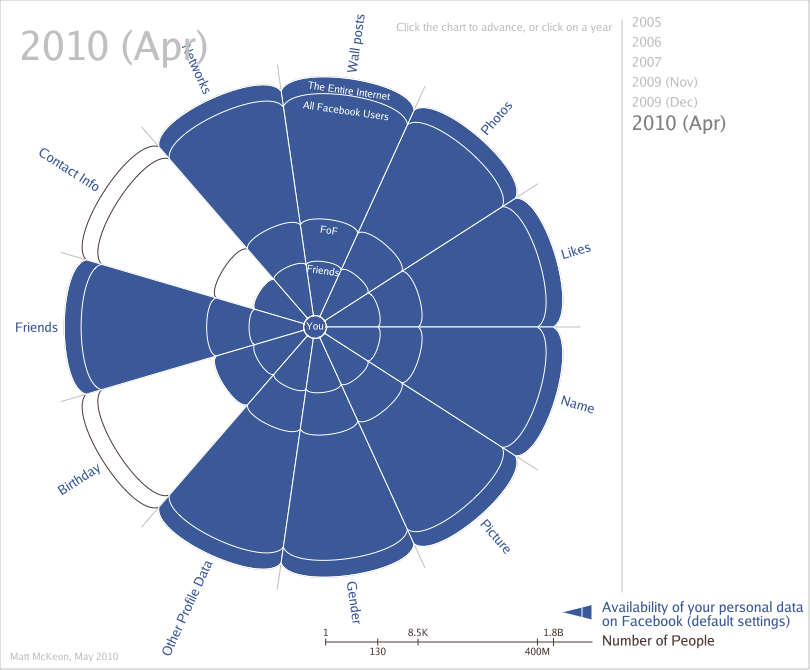May 14 2010
Facebook: It’s All About the Data
Whether you’re a Facebook user or not (I am not) it has been hard to avoid the furor recently over some of the changes the service is making. One article at Newsweek.com says:
The fear is that people are being lured into Facebook with the promise of a fun, free service, and don’t realize that they’re paying for it by giving up loads of personal information.
Why is Facebook in hot water now, when other Internet-based companies like Amazon have been collecting and using our personal data for years? Maybe it’s because Amazon doesn’t automatically add new apps to your profile if you browse other sites while logged into their service. (Facebook reportedly allows this, although some articles are now providing responses from Facebook that dispute exactly how this process is supposed to work.)
I’m not writing this post to bash Facebook (you can probably find plenty of that already). I’m writing this post because I wanted to share an interesting visualization that I found from an author named Matt McKeon. He shows how the privacy settings for Facebook have broadened over the years. He also admits that some of the data had to be “made up” because he does not have access to hard numbers from Facebook, so read the information with that in mind.
For example, in the early days it appears that your Gender information was displayed to all Facebook users but not to the Internet at large. Now it is. Your “Likes” and “Photos” were initially private; now they are also exposed to the entire Internet. Here is Matt’s take on what the initial privacy settings looked like in 2005:

scaled to fit my blog format, please click to see the full sized image
Here is the projection for the most recent privacy settings in 2010:
Scary? I think so. You can “opt-out” of some of these features, which is contrary to how I believe services like this should work. Everything that potentially exposes my personal data to someone else should be “opt-in” instead. As a slight digression: this is one of the main reasons I am not a member of any social network. I’m not a rabid privacy advocate. 🙂 But I appreciate retaining control (or at least as much as is possible) over my own information. That’s why I host my own blogs and maintain my social networks the old fashioned way.
Either way, I found Matt’s design for the graphics to be quite intuitive and easy to read. He built them with an open source javascript package named processing.js. Download link below if you are interested.
What About Other Stuff?
Facebook is hardly alone in this privacy issue. Do you use Google maps? Then you might start seeing advertisements for nearby restaurants while you’re walking downtown. Foursquare is a relatively new service that is attracting a lot of attention, and it survives only because people are willing to give up their privacy.
Remember the scene in the movie “Minority Report” where Tom Cruise is shown targeted advertisements after a quick retina scan? 😯
Related Links
- The High Price of Facebook at Newsweek
- Evolution of Privacy on Facebook blog post by Matt McKeon
- Homepage for processing.js the open source package used to build the visualizations shown above


As a slight digression: this is one of the main reasons I am not a member of any social network. I’m not a rabid privacy advocate. But I appreciate retaining control (or at least as much as is possible) over my own information.
Ditto. 🙂 I couldn’t agree more Dave. It’s funny you mention this because I was reading an article in The New York Times on the 12th http://www.nytimes.com/interactive/2010/05/12/business/facebook-privacy.html?ref=personaltech about how in 2005 Facbook’s word count of privacy statement was 1004 words. Care to guess what it was in 2010? 5830. It startlin to see the bubble diagram or the flow chart one needs to understand to manage your privacy. (Please edit this if I made any mistakes)